

Codage de Huffman. Un article de Wikipédia, l'encyclopédie libre.
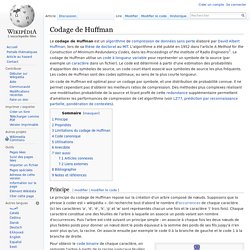
Un code de Huffman est optimal pour un codage par symbole, et une distribution de probabilité connue. Il ne permet cependant pas d'obtenir les meilleurs ratios de compression. Des méthodes plus complexes réalisant une modélisation probabiliste de la source et tirant profit de cette redondance supplémentaire permettent d'améliorer les performances de compression de cet algorithme (voir LZ77, prédiction par reconnaissance partielle, pondération de contextes).
Principe[modifier | modifier le code] Twisted Documentation: The Basics of Data Compression. In earlier days, computers were small and conserving space in memory or on a disk drive was always a premium.
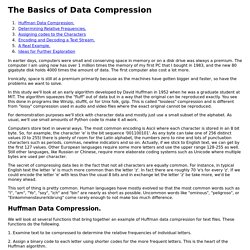
The computer I am using now has over 1 million times the memory of my first PC that I bought in 1983, and the new 80 gigabyte disk holds 4000 times the amount of data. The first computer also cost a lot more. Ironically, space is still at a premium primarily because as the machines have gotten bigger and faster, so have the problems we want to solve. In this study we'll look at an early algorithm developed by David Huffman in 1952 when he was a graduate student at MIT. The algorithm squeezes the "fluff" out of data but in a way that the original can be reproduced exactly. For demonstration purposes we'll stick with character data and mostly just use a small subset of the alphabet.
Computers store text in several ways. The secret of compressing data lies in the fact that not all characters are equally common. This sort of thing is pretty common. Huffman Data Compression. 1. Parcourir un itérable par morceaux en Python. Parcourir une itérable par morceaux signifie qu’on le traite petit bout par petit bout.
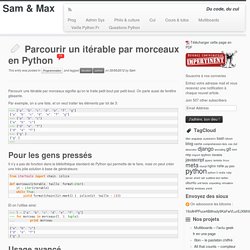
On parle aussi de fenêtre glissante. Par exemple, on a une liste, et on veut traiter les éléments par lot de 3: Pour les gens pressés Il n’y a pas de fonction dans la bibliothèque standard de Python qui permette de le faire, mais on peut créer une très jolie solution à base de générateurs: Et on l’utilise ainsi: Usage avancé Grâce au troisième paramètre, on peut récupérer une sortie sous un format différent, par exemple une chaîne de caractères: Le résultat retourné par morceaux() est un générateur: Et la fonction accepte n’importe quel itérable en paramètre, pas uniquement des listes. Ou un fichier: Comment ça marche ? Cette fonction est un concentré d’astuces propres à Python: module itertools, mot clé yield, iterable, passage de fonction en paramètre… D’abord, on utilise la fonction built-in iter(): Sur l’itérable passé en paramètre.
Python: Implementing Huffman Encoding and Decoding. Huffman coding. Huffman coding You are encouraged to solve this task according to the task description, using any language you may know.
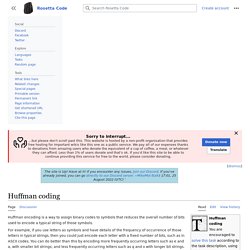
Huffman encoding is a way to assign binary codes to symbols that reduces the overall number of bits used to encode a typical string of those symbols. For example, if you use letters as symbols and have details of the frequency of occurrence of those letters in typical strings, then you could just encode each letter with a fixed number of bits, such as in ASCII codes.
You can do better than this by encoding more frequently occurring letters such as e and a, with smaller bit strings; and less frequently occurring letters such as q and x with longer bit strings. Any string of letters will be encoded as a string of bits that are no-longer of the same length per letter. To successfully decode such as string, the smaller codes assigned to letters such as 'e' cannot occur as a prefix in the larger codes such as that for 'x'. [edit] Ada. Run-length encoding. Run-length encoding You are encouraged to solve this task according to the task description, using any language you may know.
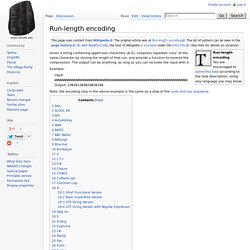
Given a string containing uppercase characters (A-Z), compress repeated 'runs' of the same character by storing the length of that run, and provide a function to reverse the compression. The output can be anything, as long as you can recreate the input with it. Example: Input: WWWWWWWWWWWWBWWWWWWWWWWWWBBBWWWWWWWWWWWWWWWWWWWWWWWWBWWWWWWWWWWWWWW Output: 12W1B12W3B24W1B14W Note: the encoding step in the above example is the same as a step of the Look-and-say sequence. [edit] Ada Sample output: [edit] ALGOL 68 Note: The following uses iterators, eliminating the need of declaring arbitrarily large CHAR arrays for caching.